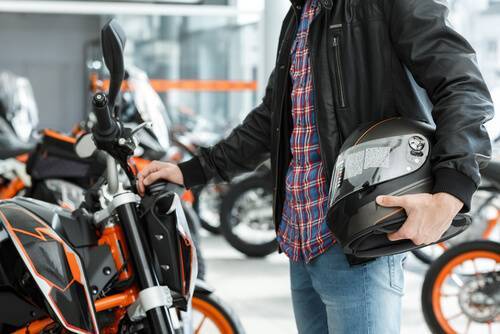
Nevada Motorcycle Law: A Brief Primer

It is well known that motorcycles and provide little protection to riders, and come with their own set of rules that must be followed. This article address some of the specific laws in Nevada that address the use of motorcycles and similar vehicles. It must be emphasized that these laws differ from state to state. Consequently, in the context of accident injury claims, it is imperative that an experienced attorney be involved.
Before we can discuss the laws, it is important to define certain terms that will be repeated throughout this article.
Moped: A motor-driven scooter, cycle, or similar vehicle, propelled by a small engine producing not more than two (2) horsepower. Mopeds must travel on less than three (3) wheels and have a top speed of thirty (30) miles per hour or less. NRS 486.038.
Trimobile: A vehicle designed to travel with three (3) wheels on the ground, with at least one of those wheels being power driven. A trimobile does not include a motorcycle with a sidecar. NRS 486.057.
Motorcycle: Every motor vehicle equipped with a seat or saddle for the driver to use and designed to travel on three (3) or less wheels excluding an electric bicycle, tractor, or moped. NRS 486.041.
Highway: The entire width between the boundary lines of every way maintained by public authority open to public use for the purpose of vehicular traffic. A highway is not simply the interstate/freeway, it is any public road. NRS 486.031.
Mandatory Use of Helmets and Eye Protection:
According to the National Highway Traffic Safety Administration (NHTSA), 4,668 individuals were killed on motorcycles in 2013. In Nevada alone, this number totaled fifty-five (55). Of those fifty-five (55), forty-eight (48) were wearing a helmet.
Because of the risks involved in driving a motorcycle, Nevada has mandated use of helmets and eye protection within its borders. Any motorcycle being driven on a highway requires the driver and passenger to wear protective headgear and protective glasses, goggles, or face shields. NRS 486.231(2).
Exemptions to Helmet and Eye Protection:
There are three (3) exceptions which allow for individuals to avoid the state’s requirement of helmets and eye protection. Drivers and passengers of a motorcycle being driven in a parade authorized by a local authority are not required to wear protective eyewear or helmets. NRS 486.231(4).
Drivers and passengers of three-wheeled enclosed cab motorcycles are not required to wear a helmet or eyewear. NRS 486.231(2).
Finally, if a motorcycle or trimobile is equipped with a transparent windscreen, a driver is not required to wear glasses, goggles, or face shields. NRS 486.231(3). A transparent windscreen does not allow you to avoid riding with a helmet.
Lane Splitting and Lane Sharing:
Lane sharing occurs when a vehicle in traffic allows other traffic to “share” the lane, commonly seen in group motorcycling. In Nevada, motorcycles and mopeds may, with the consent of the drivers, operate by side-by-side in a single lane of traffic. NRS 486.351(3). You may not ride more than two (2) motorcycles/mopeds in this side-by-side fashion.Lane splitting is the act of driving one’s vehicle between lanes of slow moving or stopped traffic. In Nevada, no person, except a police officer in the performance of his/her duty, is allowed to drive a motorcycle or moped between moving or stationary vehicles occupying adjacent traffic lanes. NRS 846.351(1)
Lane sharing also occurs in a more dangerous form, including individuals passing slower moving traffic in the same traffic lane. In Nevada, unless you are riding side-by-side as outlined above, you may not pass an individual in the same traffic lane. NRS 486.351(2).
Riding with Another Person:
A motorcycle or moped is not allowed to be driven on a highway if it is carrying more than one (1) person, unless the vehicle is designed for that purpose. NRS 486.181. All passengers are required to stay in their designated seats, whether directly behind the driver, in a rear seat, or attached sidecar. NRS 486.181(2)(a-c).
Mandatory Motorcycle Equipment:
In addition to the use of a helmet and eye protection, motorcycles and mopeds must be equipped with the following:
- Head Lamps. NRS 486.281.
- Stop Lights. NRS 486.251(2).
- Fenders On both Wheels. NRS 486.221.
Rear Tail Lights. NRS 486.261.
- Turn Signals (Excepting manufactured before 1973). NRS 486.271(2).
- Rear Reflectors. NRS 486.291(1-2).
- Brakes. NRS 486.301.
- Mirrors. NRS 486.311.
Accidents and Your Right to Recovery:
Motorcycle accidents happen, and they can lead to disastrous consequences. Even with strict adherence to the rules outlined above, you may find yourself in an accident through no fault of your own. Please keep in mind, however, that Nevada adheres to the doctrine of Contributory Negligence, meaning that your liability, if any, is spread out in proportion to your fault. One caveat to this rule is that if your fault is greater than that of the defendant’s, you will not be entitled to recovery of damages. NRS 41.141(1).
Liability and fault in a motorcycle/moped accident can come from multiple sources, not just the individuals involved in the accident. If you or someone you know have been involved in a motorcycle or moped accident, contact a Las Vegas Accident Attorney from Shook & Stone.
Our firm has been working for the injured since 1997 and can work for you so that you get the maximum financial compensation for your accident. It is important to contact legal counsel as soon as possible to avoid undue delay. With more than twenty years of experience, you can trust that we will maximize your recovery.
 Clear
Clear When Man’s Best Friend Becomes Your Enemy: Dog Bite Law in Nevada
When Man’s Best Friend Becomes Your Enemy: Dog Bite Law in Nevada 